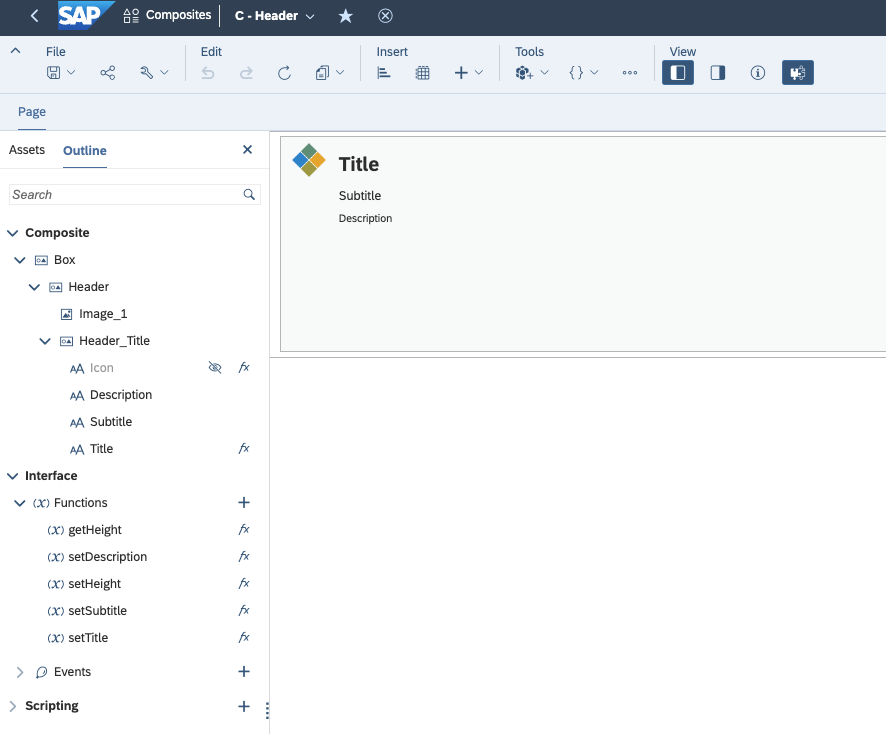
I am happy to share that Composite as reusable widget now is available with QRC4/2023 release in SAP Analytics Cloud!
A composite is a combination of widgets with configured data and scripting elements, which can be reused across optimized stories. It can be a corporate header or footer, page navigation menu, some customized dialogs or even a pre-defined chart. These composites are saved as artefacts in SAP Analytics Cloud file repository and can be transported through different tenants.
To be more concisely, composites are modular, reusable building blocks that can be plugged into any optimized story. When the story is run by the end user, it is dynamically assembled by leveraging the newest version of composites in it. With that, SAP Analytics Cloud is opening a brand new option to enable parallel and modular development, efficiently improve the development efficiency and reduce maintenance effort.
Re-usability
There are certain elements of your stories that you need to create over and over. Like a story header which contains text and a company logo, or a dialog which you can select the time period and organization unit. In the past, you need to copy and paste these header and dialogs into different stories. Or you created a template which contains header and dialogs. But if the company logo changes or another icon needs to be added to story header, then you need to manually apply these changes one by one to each story because the change of template does not automatically take effect to the existing stories.
With composite, it is no longer the case. You only need to update the change in composite, then you are done! The changes in composite can be automatically be taken over by all stories! You no longer need to manually update story one after another!
Example: Story header defined as composite

Standardization
Imagine, if you leverage the composite in your story, then all your stories have the same header, dialog, navigation menu, collapse lane etc. This extremely helps you ensure that the stories in your company have the same look/feel and the same workflow for story consumers. They no longer need to learn how to use different dialogs, different navigation menu etc. because all the dialogs across different stories have the same function, the same UX workflow based on composites.
Through standardization you can provide the corporate identity, consistency and easy-to-use aspect for story consumers. It can reduce the learning curve for story consumers to improve the working efficiency.
Example: Collapse Lane with Charts defined as composite to ensure the standardization

Modular/Collaborative Development
With the composite concept, now you have the possibility to break down the story to different parts and assign them to different story designers/developers. They can work parallel on their own composites. All the updates made in the composites, can automatically take effect in the main story. Composites opens the possibility that multiple people can work collaboratively in parallel on the same project.

With QRC4/2023 release you are receiving the below features for composite:
Creating a composite:
- via story module in tab composite
- Define Interface Functions and Events to be able to communicate between composites and stories
- Save composite as artefact in SAP Analytics Cloud file repository
Consuming a composite in Story:
- Import composite into design time
- communicating with composites via interface functions and events
Composite in general
- Composite has its own privilege. If custom role is leveraged in your company, don’t forget to assign the composite privilege to these custom roles.
- Story features like filter, bookmark, theme etc can be applied to the widgets inside composites
Current Limitation:
please refer to the restriction document here
This video demonstrates the feature highlights of composite:
With the above blog, i hope you understand the benefits and feature overview about Composite. With the next blog, i am going to dig into more details and guide you to build a composite 🙂 Please stay turned!
如有侵权请联系:admin#unsafe.sh